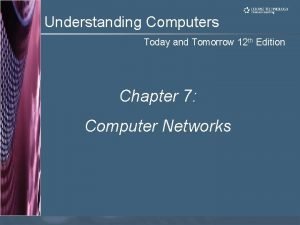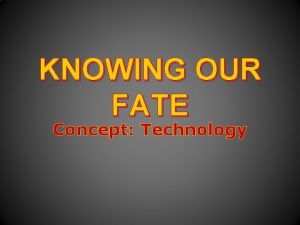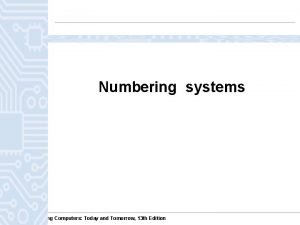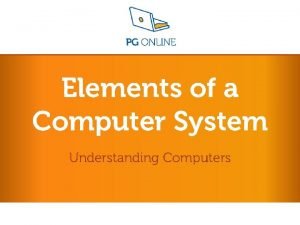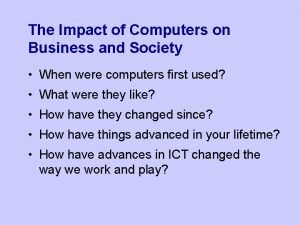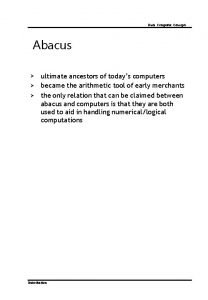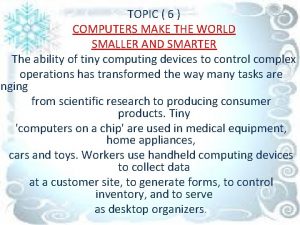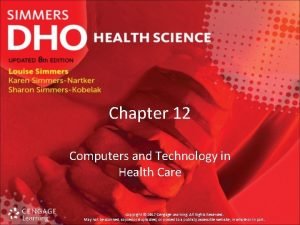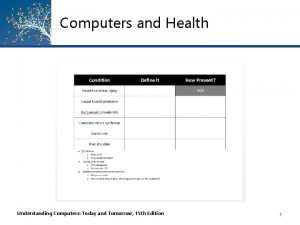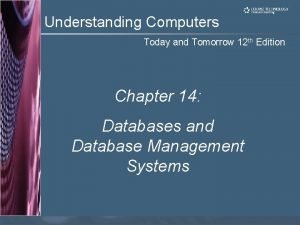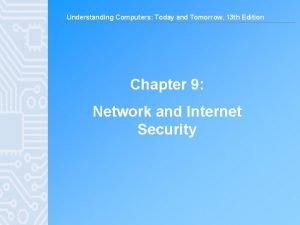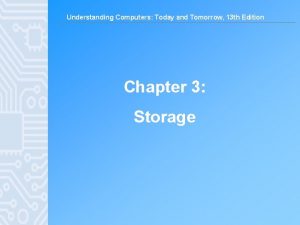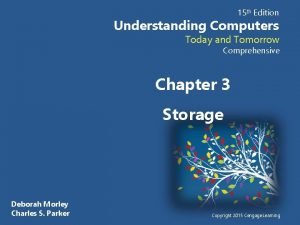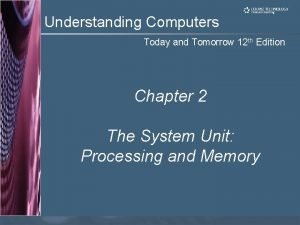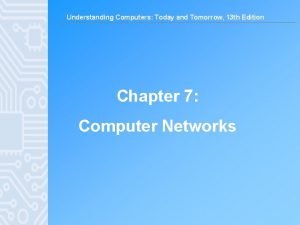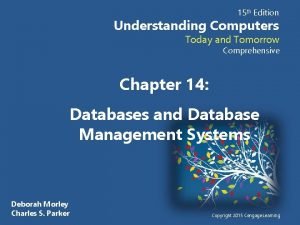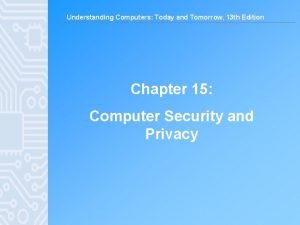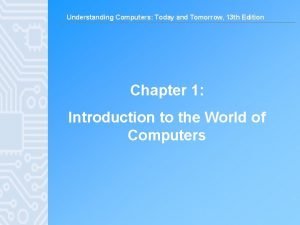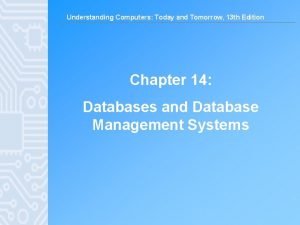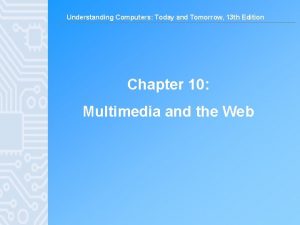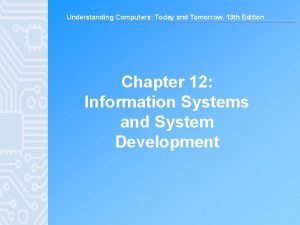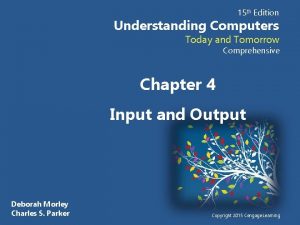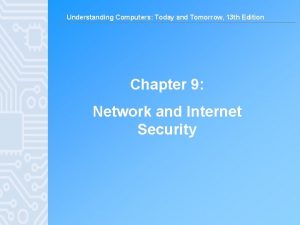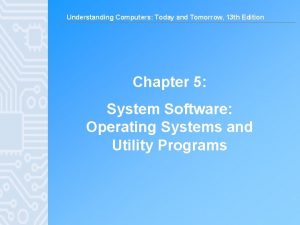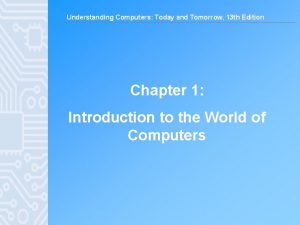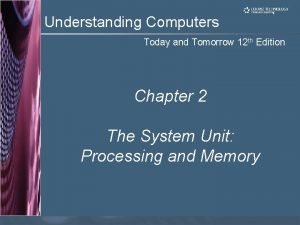Understanding Computers Today and Tomorrow 12 th Edition

























































- Slides: 57

Understanding Computers Today and Tomorrow 12 th Edition Chapter 7: Computer Networks

Learning Objectives • Define a network and its purpose. • Describe several uses for communications technology. • Understand the various topologies and architectures a computer network might use. • Explain the difference between a LAN, a WAN, and a PAN, and between an intranet, an extranet, and a VPN. Chapter 7 Understanding Computers, 12 th Edition 2

Learning Objectives • Understand characteristics about data and how it travels over a network. • Name specific types of wired and wireless transmission media and explain how they transmit data. • Identify different protocols that can be used to connect the devices on a network. • List several types of networking hardware and explain the purpose of each. Chapter 7 Understanding Computers, 12 th Edition 3

Overview • This chapter covers: – Networking concepts and terminology – Common networking and communications applications – Technical issues related to networks, including the major types of networks, how data is transmitted over a network, and types of transmission media involved – Explanation of the various ways networked devices communicate with one another – Various types of hardware used in conjunction with a computer network Chapter 7 Understanding Computers, 12 th Edition 4

What Is a Network? • Network: A connected system of objects or people • Computer network: A collection of computers and other hardware devices connected together so that users can share hardware, software, and data, as well as electronically communicate with each other • Internet: Largest computer network in the world • Types of networks – Business networks – Phone networks – Home and multimedia networks Chapter 7 Understanding Computers, 12 th Edition 5

Networking and Communications Applications • Mobile phones (wireless phones) – Cellular (cell) phones • Must be within range of cell tower to function – Satellite phones • Used where cell service isn’t available – Dual-mode phones • Allows users to make telephone calls on more than one network • Cellular / Wi-Fi dual mode phone are most popular Chapter 7 Understanding Computers, 12 th Edition 6

Networking and Communications Applications Chapter 7 Understanding Computers, 12 th Edition 7

Networking and Communications Applications • Paging – Sending short numeric or text messages to a person’s pager – Most often used for onsite paging applications • Messaging – Two-way paging – Most often takes place today via a mobile phone Chapter 7 Understanding Computers, 12 th Edition 8

Networking and Communications Applications • Global positioning system (GPS): Uses satellites and a receiver to determine the exact geographic location of the receiver – Commonly found in cars today – Available as handheld units – Used by the military, hikers, travelers, and others who need to know their precise location Chapter 7 Understanding Computers, 12 th Edition 9

Networking and Communications Applications • Monitoring systems: Monitor status or location of individuals, vehicles, assets, etc. – RFID-based systems – GPS-based monitoring systems – Electronic medical monitors and other types of home health monitoring • Digital entertainment – High-definition television/radio: HDTV is replacing analog broadcasts – Satellite radio: Delivers digital radio content to satellite receivers – Multimedia networking and digital data distribution Chapter 7 Understanding Computers, 12 th Edition 10

Networking and Communications Applications • Videoconferencing: Use of communications technology for real-time, face-to-face meetings between individuals located in different places – Technology continues to improve and mimic reallife meeting environments – Telepresence videoconferenceing – Online conferencing (via the Internet) – Video phone calls Chapter 7 Understanding Computers, 12 th Edition 11

Networking and Communications Applications • Collaborative computing (workgroup computing): Using a computer and communications technology to work together on documents and other project – Tools include Microsoft Office markup tools and collaboration software • Telecommuting: Individuals work at home and communicate with their place of business and clients via communications technologies – Possible because of the Internet and other communications technologies Chapter 7 Understanding Computers, 12 th Edition 12

Networking and Communications Applications • Telemedicine: Use of communications technology to provide medical information and services – Remote monitoring and consultations – Remote diagnosis – Telesurgery Chapter 7 Understanding Computers, 12 th Edition 13

Types of Networks • Topology: How the devices in the network (called nodes) are arranged – Star networks: All devices connect to a central device or hub) – Bus networks: All devices connect to a central cable – Ring networks: Devices connect to one another in a ring – Mesh networks: Multiple connections between devices – Some networks use a combination of topologies Chapter 7 Understanding Computers, 12 th Edition 14

Network Topologies Chapter 7 Understanding Computers, 12 th Edition 15

Types of Networks • Architecture : The way networks are designed to communicate • Client-server networks – Client: PC or other device on the network that requests and utilizes network resources – Server: Computer dedicated to processing client requests Chapter 7 Understanding Computers, 12 th Edition 16

Types of Networks • Peer-to-peer networks: All computers at the same level) – Internet peer-to-peer (P 2 P) computing: Performed via the Internet Chapter 7 Understanding Computers, 12 th Edition 17

Types of Networks • Local area network (LAN): Small geographical area (office, campus, etc. ) • Wide area network (WAN): Large geographical area (Internet) • Metropolitan area network (MAN): Serves a metropolitan area – Municipal Wi-Fi projects • Personal area network (PAN): Connects personal devices for one individual, such as his or her portable PC, mobile phone, and portable printer Chapter 7 Understanding Computers, 12 th Edition 18

Types of Networks • Wireless sensor networks (WSNs): Contain sensors (devices that respond to a stimulus and generate an electrical signal that can be measured or interpreted) • Intranet: Private network set up by an organization for use by its employees • Extranet: Intranet that is at least partially accessible to authorized outsiders • Virtual private network (VPN): Secure path over the Internet that provide authorized users a secure means of accessing a private network via the Internet Chapter 7 Understanding Computers, 12 th Edition 19

Data Transmission Characteristics • Analog vs. digital (waves vs. discrete) • Bandwidth: The amount of data that can be sent at during a given period of time – Measured in bits per second (bps) • Serial vs. parallel transmission – Serial = 1 bit – Parallel = at least 1 byte at a time Chapter 7 Understanding Computers, 12 th Edition 20

Data Transmission Characteristics • Transmission timing – Synchronous transmission (at regular, specified intervals) – Asynchronous transmission (sent when ready) – Isochronous transmission (sent at the same time as other, related, data) Chapter 7 Understanding Computers, 12 th Edition 21

Data Transmission Characteristics • Transmission directions – Simplex transmission (one way only) – Half-duplex transmission (one way at a time) – Full-duplex transmission (both ways at the same time) Chapter 7 Understanding Computers, 12 th Edition 22

Data Transmission Characteristics • Type of connections – Circuit-switched: Dedicated path over a network is established and all data follows that path – Packet-switched: Messages are separated into small units called packets and travel along the network separately • Used to send data over the Internet – Broadcast: Data is sent out to all other nodes on the network • Primarily used with LANs Chapter 7 Understanding Computers, 12 th Edition 23

Type of Connections Chapter 7 Understanding Computers, 12 th Edition 24

Data Transmission Characteristics • Wired connections: The PC is physically cabled to the network – Common in schools, business, and government facilities • Wireless connections: Typically use radio waves to send data through the air – Rapidly becoming more popular in homes and businesses – Wireless hotspots are commonly available in public locations Chapter 7 Understanding Computers, 12 th Edition 25

Wired Network Transmission Media • Twisted-pair cable – Pairs of wires twisted together – Used for telephone and network connections • Coaxial cable – Thick center wire – Used for computer networks, short-run telephone transmissions, cable television delivery • Fiber-optic cable – Glass or fiber strands through which light can pass – Used for high-speed communications Chapter 7 Understanding Computers, 12 th Edition 26

Wired Network Transmission Media Chapter 7 Understanding Computers, 12 th Edition 27

Wireless Network Transmission Media • Use radio signals – Short-range (such as Bluetooth) can connect a wireless keyboard or mouse to a PC – Medium-range (such as Wi-Fi) are used for wireless LANs and to connect portable PC users to the Internet at public hotspots – Longer-range (Wi. MAX) can be used to provide Internet access to wide geographic areas • Radio frequencies are assigned by the FCC and are measured in hertz (Hz) • The electromagnetic spectrum is the range of common electromagnetic radiation (energy) that travels in waves Chapter 7 Understanding Computers, 12 th Edition 28

Wireless Network Transmission Media Chapter 7 Understanding Computers, 12 th Edition 29

Cellular Radio Transmissions • Use cellular towers within cells • Calls are transferred from cell tower to cell tower as the individual moves • Different transmission frequencies are used to avoid interference and allow multiple conversations to take place via a single tower at one time • Widely used, but cell service not available everywhere • Cell phone technology is referred to in generations – Today’s phones are third-generation – 4 G service is beginning to become available Chapter 7 Understanding Computers, 12 th Edition 30

Cellular Radio Transmissions Chapter 7 Understanding Computers, 12 th Edition 31

Microwave and Satellite Transmissions • Microwaves: High-frequency radio signals – Sent and received using microwave stations or satellites – Microwave stations are earth-based and can transmit signals to each other over distances of about 30 miles – Signals are line of sight, so stations are usually built on tall buildings, towers, mountaintops • Communication satellites: Space-based devices launched into orbit to send and receive microwave signals from earth – Traditional satellites use geosynchronous orbit – Low earth orbit (LEO) satellites were developed to combat delay – Medium earth orbit (MEO) satellites are most often used for GPS systems • Can send large quantities of data at high speed over long distances Chapter 7 Understanding Computers, 12 th Edition 32

Microwave and Satellite Transmissions Chapter 7 Understanding Computers, 12 th Edition 33

Infrared (IR) Transmissions • Sends data as infrared light • Like an infrared television remote, IR requires line of sight • Because of this limitation, many formerly IR devices (wireless mice, keyboards) now use RF technology • IR is still sometimes used to beam data between handheld PCs or gaming systems, or send documents from portable PCs to printers Chapter 7 Understanding Computers, 12 th Edition 34

Networking Standards and Communications Protocols • Standards: A set of criteria or requirements considered to be the approved model for something • Networking standards: Address how networked computers communicate and connect • Communications protocol: An agreed-upon standard for transmitting data between two devices on a network • In networking, standards and protocols specify how: – Devices physically connect to a network – Data is packaged for transmission – Receiving devices acknowledge signals – Errors are handled – Also ensure products can work together Chapter 7 Understanding Computers, 12 th Edition 35

Ethernet • Ethernet: Most widely used communications protocol for wired LANs – Typically used a bus or star topology and twistedpair, coaxial, or fiber-optic cables – Original (10 Base-T) Ethernet networks run at 10 Mbps – Newer 100 Mbps, 1 Gbps, and 10 Gbps versions are common – 100 Gbps is in development • Power over Ethernet: Allows electrical power to be sent along with data on an Ethernet network – Most often used by businesses Chapter 7 Understanding Computers, 12 th Edition 36

Ethernet Chapter 7 Understanding Computers, 12 th Edition 37

TCP/IP and Wireless Application Protocol (WAP) • TCP/IP (Transmission Control Protocol/Internet Protocol): Used for transferring data over the Internet – Uses packet switching – TCP/IP support built into virtually all Oss – IPv 4 uses 32 -bit addresses – IPv 6 uses 128 -bit addresses and expected to eventually replace IPv 4 • Wireless Application Protocol (WAP): A standard for delivering Internet content to mobile devices – Microbrowser: Used to access WAP content Chapter 7 Understanding Computers, 12 th Edition 38

TCP/IP Chapter 7 Understanding Computers, 12 th Edition 39

Wi-Fi (802. 11) • Wi-Fi (Wireless Fidelity): A family of wireless networking standards using the IEEE standard 802. 11 – Also called wireless Ethernet – Current standard for wireless networks in home and office – Designed for medium-range transmission – Wi-Fi hardware built into most notebook PCs and many consumer devices today – Hotspots rapidly multiplying – Speed and distance of Wi-Fi networks depends on • Standard and hardware being used • Number of solid objects between the access point and the PC or wireless device • Possible interference Chapter 7 Understanding Computers, 12 th Edition 40

Wi-Fi (802. 11) Chapter 7 Understanding Computers, 12 th Edition 41

Wi-Fi (802. 11) • Various standards – Current standard is 802. 11 g – Emerging standard is 802. 11 n Chapter 7 Understanding Computers, 12 th Edition 42

Wi. MAX, Mobile Wi. MAX, and Mobile-Fi • Wi. MAX (Worldwide Interoperability for Microwave Access or 802. 16): Fairly new wireless standard for longer range wireless networking connections – Designed to deliver broadband to homes, businesses, other fixed locations – Mobile Wi. MAX is the mobile version of the standard – 4 G mobile phones may be Wi. MAX-based • Mobile-Fi (802. 20): Currently in development for providing high-speed mobile Internet access in cars, trains, and other moving vehicles Chapter 7 Understanding Computers, 12 th Edition 43

Wi. MAX, Mobile Wi. MAX, and Mobile-Fi Chapter 7 Understanding Computers, 12 th Edition 44

Short-Range Wireless Networking • Bluetooth: Very short range (less than 10 feet) – For communication between computers or mobile devices and peripheral devices – Bluetooth devices are automatically networked with each other when they are in range (piconets) • Ultra Wideband (UWB or Wi. Media): Originally developed by the military for locating tanks, enemies, hidden objects – Designed for wireless multimedia networking – Range of 100 feet or less – Speed depends on distance between devices – New Bluetooth standards will use UWB to speed up transfers of large amounts of data – Wireless USB is UWB-based Chapter 7 Understanding Computers, 12 th Edition 45

Bluetooth Chapter 7 Understanding Computers, 12 th Edition 46

Short-Range Wireless Networking • Wireless HD (Wi. HD): In development, designed for networking home electronics devices • Zig. Bee: Emerging, designed for inexpensive, simple short-range networking like sensor networks – Intended for application that require low data transfer rates and several years of battery life – Can accommodate more than 65, 000 devices on a single network Chapter 7 Understanding Computers, 12 th Edition 47

Phoneline and Powerline • Phoneline (Home. PNA): Allows computers to be networked through regular phone lines and jacks – Geared for quick and easy networking – Home. PNA 3. 0 is fast (320 Mbps) and designed for both computers and multimedia networking • Powerline: Allows computers to be networked over power lines and conventional outlets – Also designed for quick and easy networks – Home. Plug AV is fast (200 Mbps) and designed for both computers and multimedia networking • Broadband over power lines (BPL): An emerging technology that allows Internet data to be sent over existing power-pole infrastructure Chapter 7 Understanding Computers, 12 th Edition 48

Cellular Standards • Second-generation wireless standards – GSM (Global System for Mobile communications) – CDMA (Code Division Multiple Access) • Third-generation standards – GPRS (General Packet Radio Service) – EDGE (Enhanced Data Rates for GSM Evolution) – UMTS (Universal Mobile Telecommunications System) – HSDPA (High Speed Downlink Packet Access)’ – EV-DO (Evolution Data Optimized) – SMS (Short Message Service) • Fourth generation standards are under development – Some are Wi. MAX-based Chapter 7 Understanding Computers, 12 th Edition 49

Networking Hardware • Network adapter: Used to connect a PC to a network or the Internet – Also called network interface card (NIC) when in the form of an expansion card – Available in a variety of formats • PCI and PCIe • USB • PC Card and Express. Card – Adapter must match the type of network being used (Ethernet, Wi-Fi, Bluetooth, etc. ) – Are often built into portable computers Chapter 7 Understanding Computers, 12 th Edition 50

Network Adapters Chapter 7 Understanding Computers, 12 th Edition 51

Networking Hardware • Modem: Device that connects a computer to the Internet or to another computer – Term used for Internet connection device, even if not connecting via a phone line – Type of modem needed depends on the type of Internet access being used • Conventional dial-up • Cable • Fixed wireless • DSL • These and other types of Internet access are discussed in Chapter 8 Chapter 7 Understanding Computers, 12 th Edition 52

Modems Chapter 7 Understanding Computers, 12 th Edition 53

Networking Hardware for Connecting Devices and Networks • Hub: Central device that connects all of the devices on the network • Switch: Connects devices and identifies the device on the network for which the data is intended and sends the data only to that node • Wireless access point: Used to connect devices to a network wirelessly • Gateway: A devices that connects two different networks – Bridge: Usually connects wired LANs – Router: Connects networks and plans path (routes traffic) • Can be wired or wireless Chapter 7 Understanding Computers, 12 th Edition 54

Other Networking Hardware • Repeater: Amplifies signals along a network • Range extender: Repeater for a wireless network • Antenna: Used when Wi-Fi networks need to go further than hardware normally allows – Higher-gain antennas can be used with routers – Some network adapters can use an external antenna • Multiplexer: Combines transmissions from several different devices to send them as one message • Concentrator: Combines messages and sends them via a single transmission medium in such a way that all of the messages are active Chapter 7 Understanding Computers, 12 th Edition 55

Networking Hardware Chapter 7 Understanding Computers, 12 th Edition 56

Summary • What Is a Network? • Networking and Communications Applications • Types of Networks • How Does Data Travel Over a Network? • Networking Standards and Communications Protocols • Networking Hardware Chapter 7 Understanding Computers, 12 th Edition 57
 Understanding computers today and tomorrow
Understanding computers today and tomorrow Tomorrow and tomorrow and tomorrow kurt vonnegut
Tomorrow and tomorrow and tomorrow kurt vonnegut Tomorrow and tomorrow and tomorrow kurt vonnegut analysis
Tomorrow and tomorrow and tomorrow kurt vonnegut analysis Due tomorrow do tomorrow
Due tomorrow do tomorrow Due tomorrow do tomorrow
Due tomorrow do tomorrow Yesterday
Yesterday Computer today and tomorrow presentation
Computer today and tomorrow presentation What is the value of 9f16 in binary?
What is the value of 9f16 in binary? Same today tomorrow and forever
Same today tomorrow and forever Marketing today and tomorrow chapter 1
Marketing today and tomorrow chapter 1 Agriculture- yesterday today and tomorrow
Agriculture- yesterday today and tomorrow Casting crowns who am i
Casting crowns who am i A little monkey had 60 peaches answer
A little monkey had 60 peaches answer Learn today lead tomorrow
Learn today lead tomorrow The choices we make today affect tomorrow
The choices we make today affect tomorrow Students today leaders tomorrow
Students today leaders tomorrow Nursing now today's issues tomorrow's trends
Nursing now today's issues tomorrow's trends Recycle today for a better tomorrow
Recycle today for a better tomorrow Don't put till tomorrow what you can do today
Don't put till tomorrow what you can do today Field mice and bopping them on the head
Field mice and bopping them on the head Work today get paid tomorrow
Work today get paid tomorrow Where today meets tomorrow
Where today meets tomorrow A dollar today is worth more than a dollar tomorrow
A dollar today is worth more than a dollar tomorrow Royal family yesterday today is tomorrow
Royal family yesterday today is tomorrow A dollar today is worth more tomorrow
A dollar today is worth more tomorrow Nursing now today's issues tomorrow's trends
Nursing now today's issues tomorrow's trends Creating a better tomorrow today
Creating a better tomorrow today Computer applications - understanding computers unit
Computer applications - understanding computers unit Impact of computers on business
Impact of computers on business It is considered as the ultimate ancestor of the computer.
It is considered as the ultimate ancestor of the computer. Computers are your future 12th edition pdf
Computers are your future 12th edition pdf Today meeting or today's meeting
Today meeting or today's meeting Today's class was amazing
Today's class was amazing Meeting objective
Meeting objective Fingerprint ridge characteristics worksheet
Fingerprint ridge characteristics worksheet Today's lesson or today lesson
Today's lesson or today lesson Example of repitition
Example of repitition Understanding nutrition 13th edition rental
Understanding nutrition 13th edition rental Understanding movies 14th edition
Understanding movies 14th edition Understanding human differences 5th edition
Understanding human differences 5th edition Understanding earth 7th edition
Understanding earth 7th edition Folded mountains
Folded mountains Understanding earth 5th edition
Understanding earth 5th edition Adler and rodman 2006
Adler and rodman 2006 Understanding business 12th edition chapter 1
Understanding business 12th edition chapter 1 Understanding human communication 14th edition
Understanding human communication 14th edition Electron sharing
Electron sharing Linear vs relational worldview
Linear vs relational worldview Business communication today chapter 1
Business communication today chapter 1 Criminology today 7th edition
Criminology today 7th edition Using mis 10th edition
Using mis 10th edition Report
Report Up2share
Up2share Tomorrow's technology and you
Tomorrow's technology and you Tomorrows technology and you george beekman
Tomorrows technology and you george beekman Tomorrow's technology and you
Tomorrow's technology and you Computers make the world smaller and smarter answers
Computers make the world smaller and smarter answers Chapter 12 computer and technology in health care
Chapter 12 computer and technology in health care
